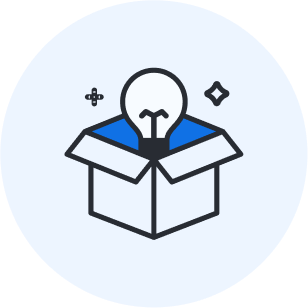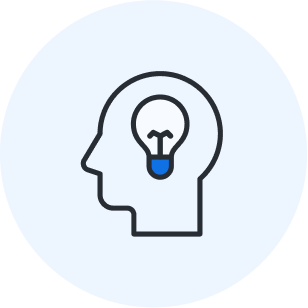The emergence of AI is the most significant shift we’ve seen in technology in decades, and implementing it into business is a priority initiative. But despite the potential benefits of AI, there’s some natural hesitation around it.
Lucid’s AI adoption survey found that 26% of employees are hesitant about AI simply because they prefer traditional methods and tools, and over a third of respondents said the biggest challenges in implementing AI are resistance to change and the need for continuous training.
Even though hesitation is valid, AI is here to stay. And just like with any major change, the mindset you approach it with can help determine your success in implementing the change. We chatted with Lucid team members who have successfully embraced AI in their roles to better understand their mindset. Here’s what they said.
Develop a lived experience of AI vs. a hypothetical one
Alyssa Stringham, senior manager of engineering at Lucid, suggests that anyone hesitant to use AI can make their opinion of AI less abstract by having a lived experience.
Big abstract ideas often come with a lot of hesitation, such as, What if I don’t like my job due to AI? What if I lose my job due to AI? If you find yourself lost in the “what ifs” of AI, ask yourself what you can control. Are you taking advantage of the tools you have access to? Do you know how they benefit your day-to-day? If you don’t, try them out so you have some concrete experience with using AI tools.
Tip for leaders: You can play a big role in managing the fear of the unknown of AI by articulating clear benefits and showing examples.
Be aware of which tasks AI can automate
Patrick Saul, solutions consultant at Lucid, says that jobs are a collection of connected tasks, and AI can and will automate some of those tasks, so you should be thoughtful about how your job may be impacted.
For example, if your job function is to research a customer segment, a lot of smaller tasks go into that. You have to conduct the research, synthesize it into a set of relevant insights, and develop key messages that are going to resonate with that customer segment—all of which requires coordination and context of your broader organizational goal. AI can’t necessarily complete all of those tasks without your context and coordination know-how, but it can likely impact those tasks or make them more efficient.
“AI can and will impact many knowledge work tasks previously thought to be too complex to automate. A job is more than just the tasks a worker performs, however."
—Patrick Saul, solutions consultant at Lucid
Saul recommends being aware of which tasks AI can assist you with by using an ideate, research, refine, and automate framework. You can think of those four areas like this:
-
Ideate: What might we do?
-
Research: How could we do it?
-
Refine: How should we do it?
-
Automate: Do it.

Ideate, research, refine, and automate
Get more information and examples for how to use AI in your daily work, no matter your role.
Read moreAI is more than advanced search
Currently, many knowledge workers are using AI as an advanced search tool because they’re used to using Google search, but the Lucid team members we talked to have experienced greater benefits from AI by thinking about it more holistically. If you approach a challenge by partnering with AI from the get-go, AI has the potential to be a collaborator rather than just an afterthought or add-on to your work.
For example, going back to the framework mentioned above, you might outline how AI can be used in each phase of a project (ideate, research, refine, automate) before you start any work. And if you aren’t sure how AI can fit in, ask the AI tool you’re using! AI differs from traditional search in that it’s better at providing nuanced insights. Plus, once you learn the basics of using AI, it has a compounding effect, and you can leverage different tools for more advanced use cases.
“Go in thinking the sky’s the limit…by trying to live in the future, you’ll see opportunities that aren’t apparent to everybody else.”
—Birch Eve, group product manager of AI, Lucid
AI can help you learn
Birch Eve, group product manager for AI at Lucid, suggests having AI help you understand things you’re unsure of or intimidated by. Start by asking yourself, “What am I trying to learn today?”
For example, maybe you attended a meeting where you didn’t fully understand the strategy discussed. You could give the meeting notes or transcript to a generative AI tool and ask it to explain it to you in a way you’ll understand better.
“Use AI to help make a plan on what it is you’re trying to accomplish, and then walk through those steps. It’s not a magical solution—it’s just an incredible way to be able to break things down simply to help you achieve what you’re trying to achieve.”
—Birch Eve, group product manager of AI, Lucid
Instead of trying to figure out the right things to Google to get helpful answers, you can ask AI your questions in a natural way, like you would a colleague, and get useful responses quickly. Simply type or say your train of thought in the prompt.
AI is a skill
Rather than thinking of using AI as a challenge to overcome, you can reframe it as an opportunity. With AI rapidly transforming entire industries, it’s important to have an understanding of new AI tools for your long-term career benefit. If you learn to use AI tools, that’s a technical skill you can put on your resume.
“AI is different from a lot of software in that you have to think deeply about what you want out of it in order to effectively get results.”
—Alyssa Stringham, senior manager, engineering, Lucid
The top AI skills we suggest you have in interacting with AI systems and applications are:
-
Collaboration
-
Problem-solving
-
Creativity
-
Critical thinking
Don’t give up after using AI once or twice
Last but not least, one of the most important things to remember when adopting an AI mindset is to not give up after only using AI once or twice. AI is changing so quickly that something AI couldn’t do a few months ago might be completely feasible now.
“The biggest mistake is trying AI and writing it off when it doesn’t work on the first few tries. AI requires shifting how you think about approaching problems, and how you communicate things, and you need to have an experimentation mindset.”
—Alyssa Stringham, senior manager, engineering, Lucid
Tip for leaders: Because AI is so new to the workplace, team members need to feel safe to “fail” in their experiments. Creating a culture of psychological safety and experimentation will play a large role in whether or not your team feels confident trying and using AI.
As you think about using AI, keep in mind that past technological advances like the phone and internet seemed novel and intimidating at first but quickly became a part of everyday life and are now second nature. There may be similar skepticism around AI, but it’s becoming more and more a part of the workplace, and your mindset around it can greatly affect how much benefit you receive from it.

Now that you know more about adopting an AI mindset, here are some dos and don’ts of using AI in the workplace.
Check them outAbout Lucid
Lucid Software is the leader in visual collaboration and work acceleration, helping teams see and build the future by turning ideas into reality. Its products include the Lucid Visual Collaboration Suite (Lucidchart and Lucidspark) and airfocus. The Lucid Visual Collaboration Suite, combined with powerful accelerators for business agility, cloud, and process transformation, empowers organizations to streamline work, foster alignment, and drive business transformation at scale. airfocus, an AI-powered product management and roadmapping platform, extends these capabilities by helping teams prioritize work, define product strategy, and align execution with business goals. The most used work acceleration platform by the Fortune 500, Lucid's solutions are trusted by more than 100 million users across enterprises worldwide, including Google, GE, and NBC Universal. Lucid partners with leaders such as Google, Atlassian, and Microsoft, and has received numerous awards for its products, growth, and workplace culture.
Related articles
6 AI skills everyone should know for the workplace and how to learn them
These are the top 6 AI skills everyone should know and how you can learn them.
A quick guide to Lucid’s AI features
Start implementing AI into your workflow in a way that works for you with these Lucid AI features.
The dos and don’ts of using AI in the workplace
Here are some dos and dont’s of using AI in the workplace you can start implementing today.
Closing the AI transformation gap: How to prepare your business for agentic AI
Uncover the greatest challenges in AI transformation and learn what steps you can take today to get your business ready for agentic AI.

